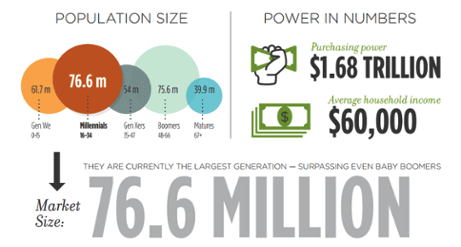
How Millennials Are Changing the Food Industry
Yes, it’s the largest living generation and there are an estimated 80 – 95 million millennials living in the United States today. While opinions vary concerning the age span of millennials, most agree it includes those born between 1980 and 2000 making them between 19 -39 years old today. Their annual spending power in the United States is expected to reach 1.68 trillion by 2020 and will represent 30 percent of total retail sales. This group is not one to be ignored.

What Influences Their Spending Habits?
- Some millennials have already settled down and started families, in fact 25% of millennials are parents and 53% of millennial – run households have kids living in them.
- Millennials are not lazy (as they are often described). Instead they are success driven with 54% either wanting to start their own business or they have already started it. They want to create their own companies and develop their own new brands.
- They’re smart! Millennials are the best-educated group of young adults in U.S. history with one-third of the older millennials having earned at minimum a 4-year college degree.
- They are an ethnically and racially diverse generation consisting of 19% Hispanic, 14% African American and 5% Asian.
- They are technically savvy having grown up with the internet and in a social media environment. Millennials will do anything to keep their tech tools close at hand – they make up 58% of mobile shoppers today.
- Traditional advertising is out for millennials, and they prefer to be reached via social platforms. The highest shares are on short captioned videos that capture attention in the first 10 seconds. They prefer a recommendation from a friend and are more likely to try and/or buy a product if a friend shares a preference with them. Anything that looks like a “paid ad” is passed over immediately. Authenticity is key.

- Millennials prefer spending money on “experiences” rather than “things” so eating out at new restaurants and trying new food venues fits their lifestyle.
- Millennials align themselves with brands and organizations with a higher purpose who are making the world a better place (think of companies like Tom’s, or Warby Parker), so when marketing to them describe your purpose first before trying to sell them your product.
- 81% of millennial retail buying occurs in a brick and mortar store and 57% make a purchase while there. Shopping online, millennials spend an average of $75 per visit. They research a lot online before making a purchase and check ingredients and product descriptions thoroughly.
What Influences Their Eating Habits?
- Nearly 60% of Millennials follow some kind of special diet including Keto, Plant-Based, Vegan and so on. Their preferences differ greatly from those of previous generations.
 44% of millennials who follow a special diet do so because it’s better for the environment and 37% believe it is more ethical. They seek out healthy, organic food options that are in line with their values.
44% of millennials who follow a special diet do so because it’s better for the environment and 37% believe it is more ethical. They seek out healthy, organic food options that are in line with their values.- Most want a healthier diet (46%), less carbs and sugar (41%) with a focus on plant-based foods (36%). They are concerned about personal well-being but also animal welfare and the risks associated with eating too much red meat.
- Nearly 80% of millennials eat meat alternatives, while 30% are trying to eat more of a plant-based diet.
- Millennials seek out sustainably sourced foods. Sales of sustainably marketed products were 113.9 billion in 2018, up 29% from 2013.
- 26% of millennials call themselves vegan or vegetarian and even millennial “carnivores” eat four or more vegetarian dinners weekly. This means one in every three meals is vegetarian for those who do eat meat.

Millennials are a powerfully different and diverse generation. Studying their habits and lifestyle makes it easier to understand why and how they buy the food and products that they do. They are a driving force that challenges long-held beliefs and traditions and we are gradually seeing a shift in the type of food being produced and developed to meet their demands. Everyone and anyone in the food business should pay close attention.
References:
- 8 Modern Tips for Marketing to Millennials, Meaghan Moraes
- The Ultimate Guide to Millennial Marketing, Neil Patel
- 27 Expert Tips for Marketing to Millennials, Neil Patel
- 10 Facts About Millennials That Every Retailer Should Know – Vantage
- Spending Habits by Generation, Plus Plant-Based Eating & Sustainability Trends: IRI Survey June 2019. Early View 2019: Food & Beverage Trends
- Trends in Millennial Diets – Food Institute Focus, Victoria Campisi
- Millennial Relationship to Food Unique from Previous Generation, Blair Shiff, August 2019
- Plant Based Food Products Started with Milk, Now Taking On Meat, What’s Next? Bernhard Schroeder
ミレニアル世代は、現時点の生存者数で米国最大の人口層となり、8,000万から9,500万人いると見積もられています。ミレニアル世代の定義をめぐっては議論があるものの、1980年から2000年に生まれた人を含むとするのが主流で、現在19歳から39歳ということになります。この人口層の米国での年間購買力は2020年までに1兆6,800億ドルに達すると予測されていて、総小売販売高の30%を占めます。とても無視できない大きな人口層です。
ミレニアル世代の消費性向に影響している要因は?
- ミレニアル世代の一部は、すでに結婚して家庭を築きつつあります。事実、25%はすでに親になっていて、ミレニアル世代が世帯主となっている世帯の53%は子供がいます。
- ミレニアル世代は、怠け者ではありません(そう言われることがよくありますが)。むしろ上昇志向が強く、54%は自分で事業を始めたいと思っているか、すでに始めています。自分の会社を起こして独自の新しいブランドを立ち上げるのが、彼らの目標です。
- ミレニアル世代は、スマートです! 米国の若年成人層として史上最も学歴が高く、相当年齢に達したミレニアル世代の3分の1は4年制大学の学位を取得済みです。
- ミレニアル世代は、民族的にも人種的にも多様な世代で、19%がヒスパニック系、14%がアフリカ系、5%がアジア系です。
- ミレニアル世代は、テクノロジーに明るく、インターネットとソーシャルメディアに囲まれて育ちました。技術ツールを身近に持ち続けるためであればあらゆる努力を厭わず、モバイルショッピング利用客の58%を占めています。
- ミレニアル世代は、従来型の広告にはなびきません。ソーシャルなプラットフォームで訴求されることを好みます。最もシェアが高いのは、キャプション付きの短い動画で、初めの10秒間で注意を引くようなものです。また、友達の推薦を好み、友達がシェアしたものであれば試したり購入したりする確率が高まります。いかにも「有料広告」という感じのコンテンツは、すぐさま無視されます。真実味があることが重要です。
- ミレニアル世代は、「モノ」よりも「体験」にお金を出すことを好みます。このため、新しいレストランや新しい食のスポットを試してみるのが、彼らのライフスタイルに合っています。
- ミレニアル世代は、崇高な目的を掲げてより良い世界の創造に寄与しているブランドや組織に親近感を感じます(Tom’sやWarby Parkerなどの企業です)。このため、企業は、製品を売ろうとするよりも前に、まず目的を説明すべきです。
- ミレニアル世代の小売支出額の81%は、実店舗で起こっていて、実店舗を訪れるミレニアル世代の57%は、その間に買い物をします。オンラインショッピングする際は、サイト訪問1回につき平均75ドルを支出します。ミレニアル世代は、購入前にオンラインで入念にリサーチし、原材料や製品の説明を徹底的に確認します。
ミレニアル世代の食習慣に影響している要因は?
- ミレニアル世代の60%近くは、何らかの食事法を取り入れていて、ケト(糖質制限)、植物由来、ビーガンなど、さまざまなダイエットを実践しています。彼らの嗜好は、これまでの世代とは大きく異なります。
ミレニアル世代の44%は、環境に良いからという理由で、また37%は、より倫理的だからという理由で、この種の食事法を実践しています。そうした価値観に合ったヘルシーなオーガニックの食品を探し求めています。
- ミレニアル世代のほとんどは、ヘルシーな食生活を好み(46%)、炭水化物と糖分は控えめにし(41%)、植物由来の食品を重視しています(36%)。自分の健康だけでなく動物愛護にも気を遣い、また赤身肉の食べすぎに伴うリスクを案じています。
- ミレニアル世代の80%近くは、肉の代替品を食べています。また、30%が、植物由来の食品を増やそうとしています。
- ミレニアル世代は、サステナブルに生産・調達された食品を好みます。サステナブルな製品の2018年の販売高は1,139億ドルで、2013年から29%増となりました。
- ミレニアル世代の26%は、ビーガンまたはベジタリアンを自称しています。「肉食」の人でも、週4回以上はベジタリアンの夕食を食べています。つまり、肉を食べる人でも、すべての食事の3回に1回は野菜オンリーということを意味します。
ミレニアル世代は、非常に異なる、多様な世代です。その習慣やライフスタイルを研究することで、彼らがなぜ、どのように食品や製品を買うのかが理解しやすくなるでしょう。この世代は、これまでの通念や伝統に挑む勢力であり、その需要に応えるために生産・開発される食品タイプの変化が徐々に顕著になってきました。食品業界にかかわっているのであれば、このトレンドを注視しないわけにはいきません。参考文献:
- 8 Modern Tips for Marketing to Millennials(ミレニアル世代に向けた最新マーケティングの8つのポイント)、Meaghan Moraes
- The Ultimate Guide to Millennial Marketing(ミレニアル・マーケティングのための究極のガイド)、Neil Patel
- 27 Expert Tips for Marketing to Millennials(ミレニアル世代に向けたマーケティングの専門家が教える27のポイント)、Neil Patel
- 10 Facts About Millennials That Every Retailer Should Know(小売業界のすべての関係者が知っておくべきミレニアル世代についての事実10項目) – Vantage
- Spending Habits by Generation, Plus Plant-Based Eating & Sustainability Trends: IRI Survey June 2019. Early View 2019: Food & Beverage Trends(世代別消費性向、および植物由来の食生活とサステナビリティのトレンド:IRI 2019年6月調査、2019年初期報告:食品・飲料トレンド)
- Trends in Millennial Diets(ミレニアル世代の食生活のトレンド) – Food Institute Focus、Victoria Campisi
- Millennial Relationship to Food Unique from Previous Generation(前世代とは異なるミレニアル世代の食べ物との関係)、Blair Shiff、2019年8月
- Plant Based Food Products Started with Milk, Now Taking On Meat, What’s Next?(ミルクから始まった植物由来食品のトレンドが食肉に波及、次なる品目は?)、Bernhard Schroeder
